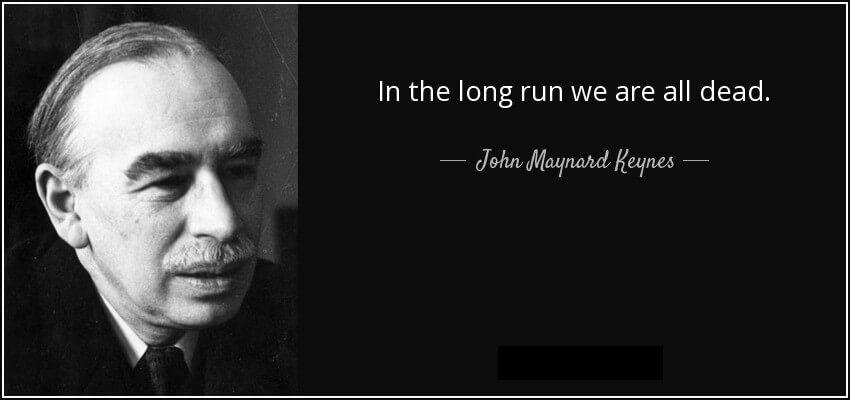Born in the year that Karl Marx died, John Maynard Keynes who belonged to the British Liberal tradition was the most celebrated economist of the last century. Perhaps, he is the second-most celebrated economist of all-time right next to that other Britisher (albeit Scottish), Adam Smith, “the Father of Economics.”
Keynesian economics dominated the politics and policies of most of the Western world more than any other doctrine in the last century. In a way, Keynesian economics was at the heart of the twentieth century’s (and still ongoing) dialogue between Capitalism/Free Markets and Socialism/State intervention. Scores of influential economists, policymakers, and politicians across the world have spent their careers (knowingly on unknowingly) in a constant dialogue with Keynes. So what is it about today’s India that makes us discussing this towering figure (he was 6’7”)?
In 1928, the soon-to-be American President Herbert Hoover had optimistically declared: “We in America are nearer to the final triumph over poverty than ever before in the history of any land.” He could not have been more wrong. Next year, on October 29, 1929, the U.S. stock market crashed. The sudden shock wiped out half the value of the U.S. shares in a single day! The blow kickstarted a global economic recession, the worst the modern industrial world has ever seen, known as the Great Depression. At its peak, the unemployment rate in America reached about 25% which has thankfully never been matched since (not even during the initial few weeks of COVID-19 when the unemployment rate touched 20%). Many factors led to the stock market crash on that fateful day like the artificial boom of the 1920s which had falsely elated President Hoover and the heavy debt owed by Europe to the United States since the conclusion of the First World War which was repeatedly being funded by America itself.
Before this time, classical economics had postulated that such a high rate of unemployment could only be transitory since markets would adjust and kickstart the economic activity once more. However, Adam Smith’s invisible hand of the market and Jean Baptiste Say’s trust in supply creating its own demand were visibly failing during the Great Depression. As sales fell because people did not have enough money to buy goods, more workforce was being laid off in an unending vicious cycle. Production in America fell by 40%. Governments around the world went into policy paralysis while untold miseries were being afflicted across the world. Amidst all this, in 1933, Keynes published an open letter to the American President Franklin Delano Roosevelt in The New York Times recommending government spending to kickstart the economic recovery. In the same year, based on this input, President Roosevelt introduced the New Deal, a package of state intervention to increase economic activity. The government undertook the construction of large infrastructure projects across the nation, introduced banking reforms, and launched welfare schemes and agencies such as Social Security Administration.
The basic idea behind the reforms was that a positive recovery loop would be created by creating new jobs that would put money in people’s hands which will generate further demand, thus negating the negative loop of the depression. It did work and not only it brought America and the world out of the depression but this increased intervention of the state was also replicated as a model across Western Europe after the Second World War. Keynes’ ideas were central to the creation of the International Monetary Fund and the World Bank after the War. However, by the 1970s as the welfare schemes exerted heavy pressure on the governments which found themselves regularly under heavy debt, a sense of disenchantment from Keynesian economics started to take shape. Under heavy pressure, President Nixon severed the link between Gold and Dollar in 1971, and the privatization of industries was undertaken by many countries across the West.
India, for the first four decades after Independence, however, had the problem of having too much Keynes in its blood. Instead of having state intervention in the economy, the state was the rice in the idly that was the Indian Economy. The state’s role in everything from the extraction of minerals to the manufacturing of automobiles has been often criticized. Only after 1991 did India cautiously take the path of economic liberalization. That remarkable pivot was triggered at a time India was facing a serious economic crisis.
Today, India is facing the greatest economic crisis in its independent history with unemployment at alarming figures. A 10% reduction in GDP in 2020 as many institutions are predicting would mean that the Indian economy has lost two years of growth even if (as we are hoping) it starts growing from 2021.
The government already recognizes that the most important way toward economic recovery may be to put more money in the hands of the people along Keynesian lines. This is why the government is doing cash transfers to the poor and investing in the MNREGA. However, this may not be enough. The economic stimulus that the government had announced has already been forgotten about by the government’s spokespersons themselves. But where would the government get more money to distribute without raising inflation or increasing its debt?
The irony is that the answer to this question of resolving the crisis through Keynesian means may lie in dismantling the Keynesian framework of the Indian state. The government can fund its debt by selling various public industries that it owns. Many of the public sector units are in loss and do not function efficiently anyway. It would not be a long step from here to disinvest from these while making sure that the jobs of the employees in these industries are protected by resettling them in various sectors.
India has had a history of implementing reforms when a crisis hits the country. More than anything, there is a race against time that the government is facing today. The positive recovery loop has to be stimulated NOW to save our poorest of the poor rather than planning for the economic recovery in the long run. Because just as Keynes wrote, “But this long run is a misleading guide to current affairs. In the long run we are all dead.”

 The Folly of Anecdotal Evidence and Today's India
The Folly of Anecdotal Evidence and Today's India